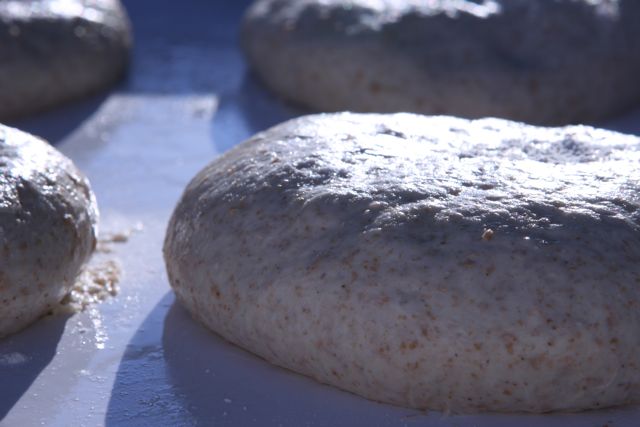Country Pizza Dough

Note the wheat-like texture
Country Pizza Dough
(Makes five 8-ounce pizzas)
I call this a country pizza dough to contrast it with a classical white dough, which is made with white flour only. This one has 25% whole wheat flour which, while not making a true whole grain dough, does give it a country, as opposed to city, feel–providing some nice earth tones as well as a more wheat-like flavor. The key is to make it wet enough so that it really pops in the oven, like the one in the video.
4 cups (18 ounces by weight) unbleached bread flour
1 1/4 cups (6 ounces) whole wheat flour
2 teaspoons (0.5 oz.) kosher salt
1 1/2 teaspoons (0.18 oz.) instant yeast (or 2 teaspoons active dry yeast dissolved in the water)
2 tablespoons (1 oz.) olive oil
1 1/2 tablespoons (1 oz.) honey
2 cups plus 2 tablesoons (17 oz.) room temperature water
–You can mix this by hand with a big spoon or in an electric mixer using the paddle (not the dough hook).
–Combine all the ingredients in the bowl and mix for one minute, to form a coarse, sticky dough ball.
–Let the dough rest for five minutes, then mix again for one minute to make a smooth, very tacky ball of dough.
–Transfer the dough to a lightly oiled work surface, rub a little oil on your hands, and fold the dough into a smooth ball. Place it in a lightly oiled bowl, cover with plastic wrap, and immediately place in the refrigerator. The dough can be used anywhere from 6 hours to three days after it goes in the fridge.
–When ready to make pizzas, pull the dough two hours prior to when you plan to bake. Divide the dough into five 8-ounce pieces (if there is any extra dough divide it evenly among the dough balls). Form each piece into a tight dough ball and place on a lightly oiled pan. Mist the dough balls with spray oil and cover loosely with plastic wrap, or place the pan inside a large plastic bag. Give the dough balls at least 90 minutes to wake up at room temperature (less on a hot day, longer on a cold day) before making the pizzas. If you don’t plan to use them all, place the extra dough balls inside of an oiled freezer bag and keep hem in the refrigerator (for up to three days) or in the freezer (for up to three months).
–If using a pizza stone in your home oven, preheat the oven to the highest setting one hour before you plan to make the pizzas. If you do not have a baking stone you can bake the pizzas on a sheet pan. If using a wood-fired oven, you know what to do for your particular oven.
Recent Articles by Peter Reinhart
- Update from Peter Regarding our Heritage Radio Network Audio Podcasts
- Pizza Quest: Chef Mike Friedman’s Pizza and Other Jewish Italian American Tributes in DC
- Pizza Quest: Animal-Free Cheese that Actually Tastes and Melts Like Cheese
- Pizza Quest, with Guests Jillana Miller and Ahmad Butler, aka Miller-Butler
- Pizza Quest: Shannon Mangini — Things Can Happen Fast
- Pizza Quest: Anthony Mangieri, with Big News About His New Line of Frozen Pizzas
Add Comment
You must be logged in to post a comment.










The country dough says “2 teaspoons active dry yeast (dissolved in water)”. Is this water in addition to the 2 cups 2 teaspoons called for later in the recipe? If so, how much water should it be? I am guessing the yeast is just supposed to be added to the 2 cups 2 ounces, but want to be sure. Thank you!
This is a really interesting pizza dough I think I am going to try out. One thing I find interesting is that you don’t knead this dough at all–no attempt to get it to the traditional “window pane” stage. Why is this?
Two great questions! Yes, add the yeast to the water in the recipe, not to any additional water. And, as for kneading, there is a little kneading involved, just enough to get the dough developed, but most of the gluten development will happen during the cold fermentation and when you form the dough balls. The overnight method, which I’m using more and more (ever since I wrote “Artisan Breads Everyday,” which uses this technique exclusively), replaces the need for long kneading–just one of its many benefits!
Hmm, thanks for the quick reply. I too, have been using the cold fermentation method with bread making, ever since I bought and read your American Pie book, which is by far my favorite cooking book.
I didn’t realize that the overnight fermentation helped to that extent with the gluten formation. Great info. Thanks!
Hi! Congratulations Peter – this new web page is so nice! And pizza is always a perfect theme! 🙂 I made half of this dough – we made two “winter pizzas” with it: one with dried and smoked reindeer meat and herbs and another “dessert-kind” with pears, figs and blue cheese. The strong wheaty crust fit great in these flawors! Yum Yummy Yum! Thank you!